Sanibel is Hurting
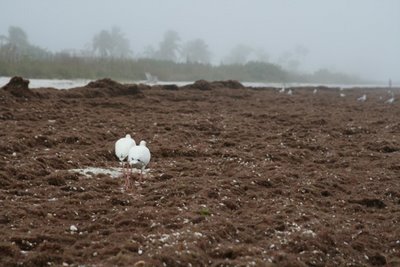 How I missed my mate. I thought of him as I watched these two white ibis pick their way slowly down the messy beach. Truth be told, I thought of him the whole time. Tonight, he's the one in Florida, calling to say he's renting a car, driving with the windows down, looking at a wood stork. Sigh. What is this work we do, that separates us time and time again?
How I missed my mate. I thought of him as I watched these two white ibis pick their way slowly down the messy beach. Truth be told, I thought of him the whole time. Tonight, he's the one in Florida, calling to say he's renting a car, driving with the windows down, looking at a wood stork. Sigh. What is this work we do, that separates us time and time again?Everything had changed this year at Sanibel. For one thing, the famous Australian pines that once graced and shaded the island are all gone, every one of them blown down by the hurricanes. The native canopy trees in the flatwoods are virtually all gone, and the palmettos and ferns bake in the unrelenting sun.
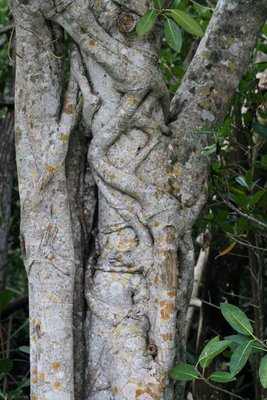 The runes on these trees were in bas relief. Still unreadable to me.
The runes on these trees were in bas relief. Still unreadable to me.But even more had changed this time than it had in March 2006, when we were last there. The first and most obvious change was in Sanibel's justly famous white-sand beaches. I couldn't see any sand, except high up near the dune grass. The beach was covered, as much as a foot deep, in red drift algae. It took awhile, and some questions to residents, for it to sink in on me what the things I was noticing really signified. I'm glad I didn't know what it meant while I was photographing birds. I was just thrilled to be on a beach, near the ocean, weedy or not.
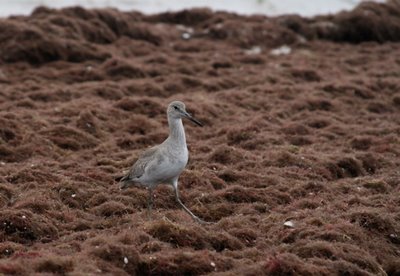 A willet makes its way along. I'll bet it misses the sand, too. How do you forage in this stuff?
A willet makes its way along. I'll bet it misses the sand, too. How do you forage in this stuff?Red drift algae is a plant that flourishes in the presence of nitrates and pollutants. At Ding Darling NWR, there were mats of green filamentous algae on the bottom of the impoundments, and floating near the top of every body of water. This crud has the same dietary preferences as red drift algae. Nitrates. And where do those come from? Read on.
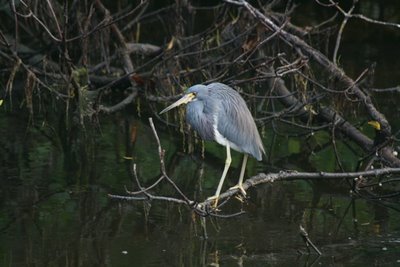 You can see the green mat algae on the mangrove roots in this otherwise pleasing picture of a tri-colored heron.
You can see the green mat algae on the mangrove roots in this otherwise pleasing picture of a tri-colored heron.As I picked my way through the red drift algae out on the beach, I found something I'd never seen before--dying calico scallops. We're all used to seeing their shell halves cast up. That's normal. These were alive and clapping their shells, dying by the thousands. I picked up the first dozen or so that I saw, and winged them back into the water. And then I realized that if I were going to try to help every scallop on the beach, I would be there a very, very long time. I was there quite awhile as it was, until I realized that these scallops were all going to die whatever I did.
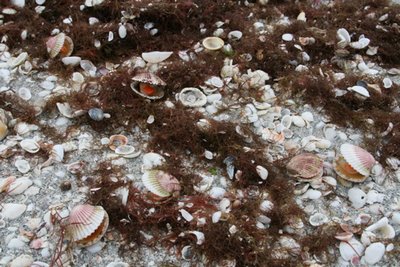 It was a massive die-off, and it wasn't normal, because healthy scallops don't permit themselves to get washed up. For as long as I watched the gulls and shorebirds, not a single one attempted to eat these large exposed morsels of protein. That seemed really strange. Why would a ring-billed gull walk right past an open scallop? But birds know much that I can't fathom, and they know what is fit to eat and what is not.
It was a massive die-off, and it wasn't normal, because healthy scallops don't permit themselves to get washed up. For as long as I watched the gulls and shorebirds, not a single one attempted to eat these large exposed morsels of protein. That seemed really strange. Why would a ring-billed gull walk right past an open scallop? But birds know much that I can't fathom, and they know what is fit to eat and what is not.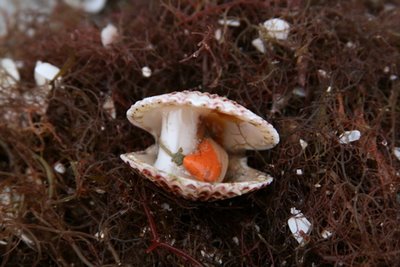 I saw them as fellow animals, and felt them suffering, these humble mollusks who receive little empathy from anyone. We put them in sauces and serve them with pasta, but we don't think about them as fellow beings. The way they'd close when they sensed me near, then slowly re-open, broke my heart. You can tell the girl from Ohio, because she's the one flinging scallops back into the sea.
I saw them as fellow animals, and felt them suffering, these humble mollusks who receive little empathy from anyone. We put them in sauces and serve them with pasta, but we don't think about them as fellow beings. The way they'd close when they sensed me near, then slowly re-open, broke my heart. You can tell the girl from Ohio, because she's the one flinging scallops back into the sea.So there was a very strong visual element to my distress, but what bothered me most was what wasn't there. Namely, fish-eating birds. No wood storks. Almost no pelicans. Few cormorants. Only a sprinkling of shorebirds, even at low tide. Very few ospreys. And few herons and egrets. I think I saw one great egret fly over Ding Darling, only a handful of other egrets fishing. It was eerie, and wrong, and scary as hell.
What few fish were there were hotly contested by brown pelicans, double-crested cormorants, and a small flock of red-breasted mergansers. You can see the white collar of the drake merganser right under the airborne pelican's right foot. He's periscoping, looking for fish with his head underwater. The drab duck is a hen red-breasted merganser.
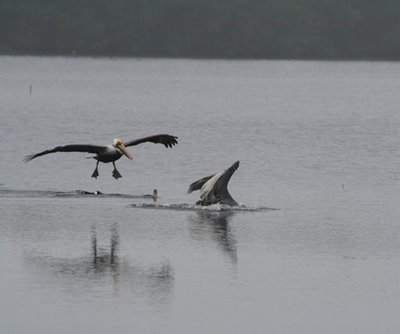
So what happened? What is happening?
Well, when the multiple whammy of hurricanes hit Florida, Lake Okeechobee way up north of Miami got really full. Since the lake is surrounded by land owned by an entity referred to by Floridians as "Big Sugar," and stands in heavily sprayed and fertilized sugar cane, Okeechobee gets the worst agricultural runoff imaginable. It's full of nitrates (which act as fertilizer for algae), herbicides, pesticides and other toxins. If nature were allowed to take its course, the cane fields would have flooded. But the Army Corps of Engineers, protecting Big Sugar's interests, decided that that would be unacceptable, and released huge pulses of toxic water into the Caloosa River, whose mouth opens out onto that precious bit of sand and mangrove flat and habitat called Sanibel Island. Flood an ecosystem with toxins and fertilizers, and you get mats of algae, massive fish kills, shellfish kills, bird die-offs, and repercussions untold for years to come.
Ding Darling NWR was quiet, too quiet. I cursed my inquisitiveness, and wished I could just shrug and shake my head like the woman from Michigan who I stopped and asked about the dying scallops. " Never seen anything like it! They're just a clappin' away!" she chuckled, and slogged on through the red algae. Yeah.
The coastal beaches on Sanibel were all but unwalkable, their famous shells buried inextricably in mats of fibrous algae. The mullet whose splashing leaps were such a signature sound and sight of the refuge were completely gone. I saw one lone mullet, cavorting in a mangrove channel, where there were thousands before. (I saw more human mullets fishing than actual fish.) There were no fish, so there were almost no birds. I saw not a single wood stork on the refuge. And I fear for the upcoming nesting season for all fish-eating birds.
But the cane fields didn't get flooded. Ay, oh... way to go, ACOE.
I could tell on approaching this yearling yellow-crowned night heron that he wasn't right.
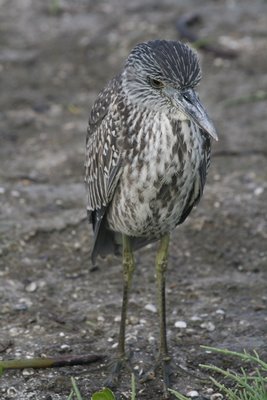 Even a tame night heron shouldn't have his eyes closed when a human's only eight feet away. He swayed on unsteady legs, eyes shutting. His soft part coloration and his eyes were dull. And then I saw his feet, covered with suppurating sores. This heron is not long for this world. Wading in poisons has opened these sores, poisoned his blood.
Even a tame night heron shouldn't have his eyes closed when a human's only eight feet away. He swayed on unsteady legs, eyes shutting. His soft part coloration and his eyes were dull. And then I saw his feet, covered with suppurating sores. This heron is not long for this world. Wading in poisons has opened these sores, poisoned his blood.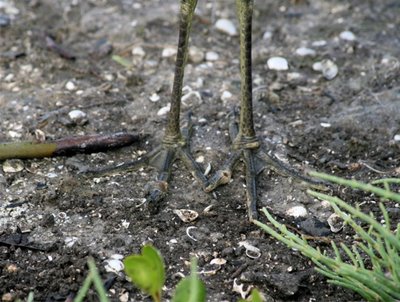 For someone who has seen this refuge in its glory, so many birds crammed into the pools that they have to take a number, it was hard to witness the quiet. I wept inwardly as I wandered from empty pool to empty pool.
For someone who has seen this refuge in its glory, so many birds crammed into the pools that they have to take a number, it was hard to witness the quiet. I wept inwardly as I wandered from empty pool to empty pool.So it's up to the mangroves now to slowly filter and heal these waters, to shelter what baby fish are able to hatch in poisoned water.
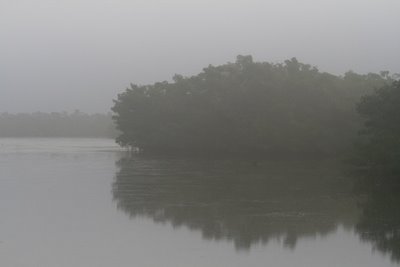 Hurricanes happen. They're nobody's fault, though we have to wonder whether global warming is making more and bigger hurricanes than ever before. As for water releases from Lake Okeechobee, we've let Big Sugar call all the shots; the Army Corps has done what it can to satisfy that entity's economic interests and make sure the cane fields don't flood, and the Sanibel mangroves have a big job, and strangely quiet waters, in front of them.
Hurricanes happen. They're nobody's fault, though we have to wonder whether global warming is making more and bigger hurricanes than ever before. As for water releases from Lake Okeechobee, we've let Big Sugar call all the shots; the Army Corps has done what it can to satisfy that entity's economic interests and make sure the cane fields don't flood, and the Sanibel mangroves have a big job, and strangely quiet waters, in front of them.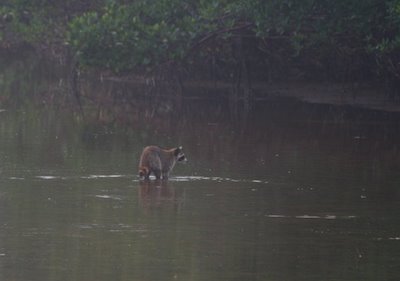 It was good to see a raccoon acting like a raccoon--rummaging through mudflats instead of trash cans. I remembered the book, "Ring of Bright Water." What a lovely title.
It was good to see a raccoon acting like a raccoon--rummaging through mudflats instead of trash cans. I remembered the book, "Ring of Bright Water." What a lovely title.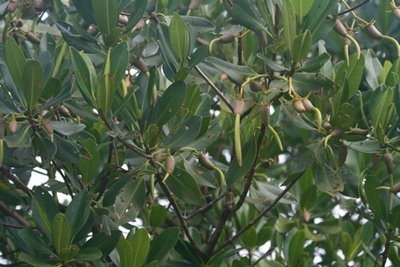 And yet the red mangroves seem hopeful. Their seeds, among the only ones in the plant world that germinate before leaving the mother plant, send a fine green root down before falling into the mud below. May they do their work well.
And yet the red mangroves seem hopeful. Their seeds, among the only ones in the plant world that germinate before leaving the mother plant, send a fine green root down before falling into the mud below. May they do their work well.A cormorant stares into the water beneath its perch, looking for fish.
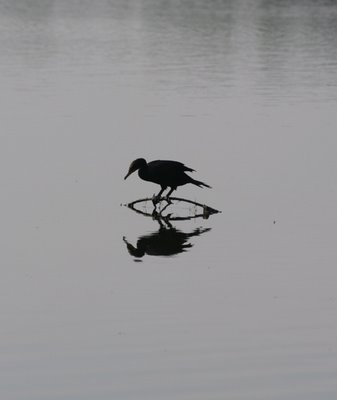
When it leaves, the branch springs up: a perfect fish, complete with eye, gill cover, pectoral fin and tail-- but one no bird can eat.

Heartfelt thanks to Dan and Judy Davis, refuge volunteers who took me out to the quiet pools and explained so much to me. Sorry to have a bummer post, but it isn't all beautiful, this place we called Paradise.






<< Home